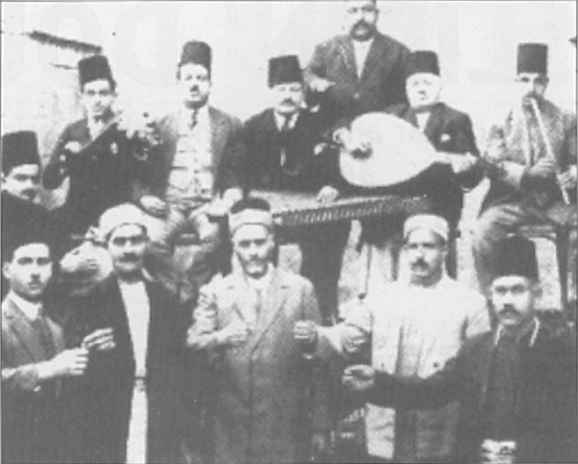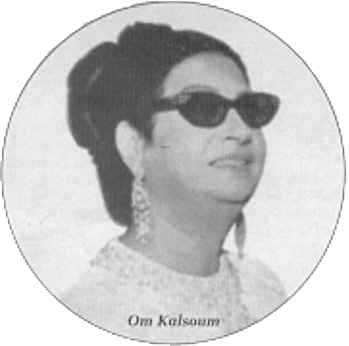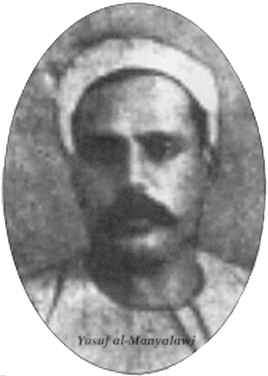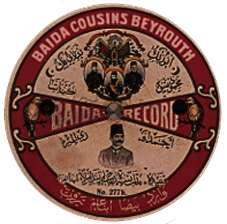
CAIRO PRACTICE
This month Paul Vernon's time-machine pauses for a look at the early days of
Arab music recording
As the 19th Century gave way to the 20th, Cairo was a cosmopolitan city of more
than a third of a million people, Over 80 per cent were Egyptians, but the balance
was made up of Greeks, Italians, French, Austrians, English, Germans and Turks. The
reason most of them were there was trade. Cairo was, strategically and economically,
the hub of all commerce between Western Europe and the Arab countries.
With a booming economy, a measure of political stability and no immediate threat
of war, successful Egyptians looked for novel ways of using their disposable income.
The great novelty of that era, the talking machine, was therefore in a prime position
to take a handsome slice of new business.
As early as 1894, talking machines and records, available by mail from London
and Paris, had been advertised in the Cairo press. However, the records offered were
those standard mix of Opera, military bands, cornet solos and popular European song.
It became clear to the early record companies that much greater success could be
gained by making records of what they themselves referred to as 'Native Music'. In
the spring of 1903 the London-based Gramophone Company sent engineer Franz Hampe
to Cairo where he made 165 single sided recordings. Later that same year, his endeavours
having been manufactured in London and shipped back to Cairo, the first catalogue
of Arab music was presented to an eager public.
To understand the impact that this innovation had upon its intended audience,
it is necessary to remember that none of them had ever heard a mechanical reproduction
of Culturally relevant music before. As in India, where similar events were occurring
at the same time, the Egyrptians took to the gramophone with an enthusiasm that caused
smiles of satisfaction to cross the faces of record company executives in England.
The following year, competition kicked in with a vengence, German Odeon, newly
formed and very aggressive, sent their recording expert John Daniel Smooth to Cairo
to create a catalogue with which to compete in this fast-expanding market. Within
months, the Gramophone Company's American expatriate expert W. Sinkler Darby had
been despatched to make a series of 12" 78 rpm records to add lustre to their
catalogue. By 1905 the Egyptian music afficionados had been confronted with a considerable
choise.
What they were being offered was a remarkable selection of genuine traditional
music. Classical, improvisational, poetic, theatrical and popular styles were all
represented, and the musicians were almost always people who brought a deep understanding
of the idiom to their art.
Yusuf al-Manyalawi, the most important of the early singers, had been a court
musician to King Abd al-Hamid and when first recorded by the Gramophone Company,
in about 1905, he was already 65 years old. Held in awe by other musicians and the
public alike, his records were not only commercially successful but also immensely
important artistically. From 1908 until his death in 1911 he recorded extensively
for the Egyptian owned Sama al-Muluk (Choice of Kings) label, an enterprise founded
by local business people specifically to promote his music. Years after his death,
much of his extensive repertoire was still available.
As the public demand for authentic music grew, two things happened. First, more record
companies entered the field. By 1910 French Pathé and the Baidaphon company,
owned and operated not by Europeans but by the Baida brothers, Lebanese businessmen,
had both produced significant bodies of music.
Second the nature of the gramophone itself began to alter the character of the music.
Because it was only possible to record a maximum of three and a half minutes on one
side of a 78 rpm record, many early Egyptian records are at least two parts, and
sometime four spread over two discs. However, the musicians had to stop every time
a side finished and then start again. Not used to these restrictions, some found
difficulty in adjusting to the technology and remained little recorded. Others, Manyalawi
included, adapted well and prospered as a result. The music itself bent to the restrictions
of the fledgling industry.Shorter, through-composed pieces were produced specifically
for recording purposes, and larger instrumental ensembles, difficult to record accurately
in the early acoustic days, were pared down to quartets and trios.
Arguably, then it can be said that the gramophone itself altered the course and character
of Egyptian music. What we hear today in old records has much to do with the technical
limitations of early recording as it does the music itself. That said, what is left
constitutes a remarkable legacy.
Cairo became the centre of all Arab recording activity throughout the first 30
years of this century. From Syria and the Lebanon, from Damascus and Jaffa, artists
travelled to Cairo to record for the major European companies. Seeing this situation
clearly, the Lebanese Baidaphon company set up a Cairene branch office in 1914 and
began making a wide variety of Arabic music available. Algerian, Moroccan and Tunisian
styles are all represented in the early Baidaphon catalogues, along with their competitive
efforts at challenging the major owned company's domestic output.
The 1914-18 war affected business to the degree that, as a result of its outcome,
and Egypt being placed under a British protectorate, only the English Gramophone
Company and French Pathé relocated and started taking recordings elsewhere
in the Middle-East. Pathé concentrated on Algiers, Morocco and Tunisia, perhaps
largely due to their all being French colonies at the time. Odeon also turned its
attention to these areas and both Columbia and Polyphon began building catalogues.
The recording of Arab music was about to enter a new era.

Om Kalsoum
With the perfection of an electrical recording process in 1925, a 30 year period
of exclusivity was drawing to a close. While the gramophone business had been acoustic
in nature, the private ownership of a machine had largely been the privilege of those
with money. This effectively meant that in any country with a class system of any
kind, the proletariat were often excluded and therefore not catered to by the companies.
With the new technology, however, mass production of records became easier and cheaper,
and portable machines had been perfected that could be manufactured and sold cheaply
in large quantities. The result was a world-wide explosion of recording activity
with the mass market as its target. In almost every country, from North America to
Portugal, from Greece to Argentina, a massive explosion of recording activity occurred
from 1926 onwards, one that would last for almost five years!
FoLK ROOTS 27
Throughout the Arab world, the new access to cheap music was met with deep enthusiasm.
Those who could not or did not purchase their own machine were exposed to the medium
in coffee houses. In even the most afflicted low-income areas one could listen to
the gramophone simply by taking a coffee or a nargile. The music spread through rural
Egypt by rudimentary dissemination. In small towns and villages the mayor or elder
often possessed a machine and, in tight-knit communities, publicly shared recitals
were common. Travelling 'Music Men' - street level entrepreneurs with a handcart
mounted wind-up gramophone and a selection of records - earned a living of sorts
by offering to play any tune of choice for a small fee.
Interestingly, this practise was common in India also.
It was in this way that Om Kalsoum first heard recorded music. Her father, a Qur'an
reader in a rural community, had taught her his skills when she was still a child;
growing up with the influence of religious instruction and exposure to both live
and recorded music, her natural skill was recognised early enough to send her to
Cairo for further voice training. By 1926, when Kalsoum was about 22 years old, she
was considered good enough by the Gramophone Company to make commercial records.
Kalsoum's success was almost instant. From her first session, only a year after
recording had gone electric, until her death in 1975, she was Egypt's best loved
and most revered singer. Her records sold in huge quantities and the Gramophone Company
paid her what was then an enormous sum of money - £25 per song - to keep her
services. An interesting insight into Kalsoum, in the form of a letter sent to the
Gramophone Company by the engineer who recorded her, survives;
"Hotel Continental, Cairo, 21/4/29
We are experiencing great difficulty in making arrangements with Omm Koulsoun
(sic), she came to the studios on Friday last at 9.30 after making an appointment
for 7 o'clock. At 10.30 she started singing. After making one title which took an
hour to rehearse she decided it was no good. This is the usual procedure and we are
accustomed to it. Having decided she would sing no more that night she left saying
she would not come again until the 4th of May. This evening she has telephoned saying
she will start recording again on the 29th. You will understand it is impossible
to give any date as to when we are likely to finish.
Faithfully, E. Fowler"
Despite Fowler's complaints, Kalsoum's output remained prodigious.
By 1929 more than725,000 individual recordings of Arab music had been made, an
average of over 275 double sided records a week since recording had begun a quartercentury
earlier. This may take the modern reader somewhat aback. However, several factors
contributed to this staggering figure and they need to be enumerated so that the
statistic can be more fully understood. The 'Arab World', as the early record companies
perceived it, stretched from Morocco to Persia and south into lower Egypt and the,
Sudan, an area larger than the United States. From the record company's point of
view it also y included the United States where, by 1924, there were over 400,000
immigrants of
Arab origin. With no competition from any media other than the silent cinema,
record companies absorbed almost all the disposable income that people spent on passive
entertainment. For the companies, records were easy and cheap to produce. Royalties
were almost unheard of and artists' fees were often at a level that would today be
considered derisory. It was, in short, a fat time for the record industry.
By 1929, statistically the peak year of recording activity world wide, seven separate
companies, five of them European, were actively engaged in recording and selling
almost all forms of Arab music. Significant catalogues of Algerian, Egyptian, Iraqi,
Lebanese, Moroccan, Persian, Syrian and Tunisian music were being offered by all
of them.
In late 1929 the first pinpricks began appearing in the bubble. When Wall Street
crashcd in late October, and panic .subsequently spread throughout the western world,
the effect on the record industry as both immediate and disastrous. By the middle
of 1930 overall sales had dropped dramatically. The answer to this problem, as far
as European companies were concerned, was to close ranks and retrench. In consequence,
the major firms, Columbia, The Gramophone Company, Odeon and their smaller affiliates
amalgamated into the Electrical and Musical Industry Company - EMI for short. While
they were busy tightening belts, technologies that would threaten the dominance of
sound recording were advancing.
By 1931 sound films were the new rage throughout North America and Europe, and
radio, although operative in many parts of the world since the early '20s, now came
of age. The stranglehold that record companies had had on the home entertainment
market was therefore loosened.
Specifically in Arab countries these developments meant that three separate media
now competed for customers' money. The record industry didn't fold, but it did have
to accept that it could only get a slice of pie rather than the whole dish. In 1932
Egypt experienced its first sound film, and, as in India the previous year, the impact
was both immediate and dramatic. In parallel with the Indian experience it also had
the effect of re-focussing both the record companies' goals and of re-shaping the
music itself. Regional styles, while they did not disappear, took second place to
a burgeoning demand for film hits designed to appeal to a wider audience. In effect,
Arab music went 'commercial'. The film hits were popular songs accompanied by orchestras,
many almost western in approach.
Had it not been for the counterbalancing influence of radio, much Arab traditional
music might have withered and fallen from grace during the '30s. However, beginning
in 1934 the I governmentsponsored National Radio actively promoted traditional music
by broadcasting up to eight hours of recordings and live concerts daily. Om Kalsoum,
still the most popular female star, and Mohamed Abd alWahab, her male equivalent,
made a quick and easy transition to this new medium. In fact it promoted Kalsoum
to superstardom. Her monthly radio concerts attracted such huge audiences that virtually
all other activity ceased in Cairo for their duration Om Kalsoum Night became a national
habit .
Radios were cheap, ubiquitous and required no further investment in the way a
gramophone did. Everyone had the opportunity to listen and most did. As a result,
and also partly due to Kalsoum's direct influence, the quality of Egyptian radio
consistently improved throughout the '30s.
Records continued selling throughout all these upheavals, with the giant EMI organisation
still controlling most of the market. Cairo lost some of its pre-eminencc as a recording
centre, partly because the nature of recording itself had changed. With electrical
equipment it was easier to go on location where necessary, but with competition largely
eliminated by the 1931 merger, EMI established single recording centres in key cities
throughout its territories.
Paris became the major centre for the recording of Algerian, Moroccan and Tunisian
musicians. La Voix du Son Maître, EMI's main French label, issued the bulk
of this music on their ‘K’ prefix series and drew often upon musicians resident in
Paris. This fascinating legacy provides us today with an opportunity to listen to
much traditional North African music that might otherwise have gone unrecorded.

[picture of Yususf al-Manyalawi]
The 1939-45 war severely interrupted the Arab music industry. The three major
foreign countries involved in recording all became embroiled in war, and they also
brought their conflict to Arab soil. Despite these events, the hardship they brought
and the consequent shortage of raw materials, the Baidaphon label kept Up a solid
output of new material. Pressing were made for them in neutral Switzerland and throughout
the war Arab communities continued to enjoy both recorded music and radio broadcasts.

After hostilities ended and the companies picked up the pieces, it was more or
less business as usual. From 1946 into the late '50s the industry continued to service
Arab markets, introducing vinyl in from locally owned companies, including Baidaphon
(now renamed Cairophon) and Misriphon challeneged the western conglomerates on home
turf. Throughout the '50s the Northern European recording empire started to fragment
in a variety of complex ways. In Egypt politics and social revolution had something
to do with the waning of influence but technology had a greater impact. Television
was launched in 1960 and, quite naturally, Om Kalsoum made the leap to the new medium
with customary success. TV fascinated the Cairenes as it did almost everyone else
in the world, and the new medium was often used to promote music in the form of concerts
and musical plays. With the advent of tape it was suddenly easier and cheaper to
make records.
With the appearence of cassettes in the early '70s the music fell back into the
hands of small street level entrepreneurs. Music industry protestations that 'home
taping is killing music' had little effect upon either the manufacturer, the retailer
or the customer.
In a 70-year period, a surprisingly large quantity of authentic Arab music has
been preserved for posterity. The roots of current Shaabi and Rai styles speak for
themselves in the old recordings. They are voices worth listening to.
With thanks to Bibliotheque Nationale, Paris; British Library; EMI Archives; Michael
Kinnear; Scott Lund and The National Sound Archive.
Published sources consulted: Popular Musics of the Non Western World (Peter Manual);
Grove Dictionaly of Music & Musicians and notes to CDDA & Ocora CD's.
Recommended Listening: The Frenchbased 'Clube De Disques Arabcs' have reissued
eight volumes of Om Kalsoum covering the period 1926-37 and ten volumes of Mohammed
Abd el-Wahab from 1920 to 1939. They have also compiled a fascinating set by El Hadj
Mrizek, an important Algerian singer from 1930-32 which represents the only currently
available example of early Algerian styles. Yusuf-AI Manyalawi is also represented
by a reissue of some of his best work on this enterprising label. The label is distributed
in England by Sterns; in Paris you can walk into FNAC' and pick them off the shelf.
In London try Virgin; in the U.S., Tower. Or write to them directly at: 125 Bd de
Menilmontant, 75011 Paris. You may see Om Kalsoum's name spelt as Umm Kalthum. It's
the same person. The phonetics are sometimes changed to reflect pronunciation
If you want to dabble first, then Ocora have an excellent CD entitled Archives
de la Musique Arabes 1910-20 which provides important examples of seminal styles
from Egypt and Lebanon in surprisingly high solid quality, and is accompanied by
an excellent and well illustrated booklet in Arabic, English and French. This issue
and all the CDDA's arc also available on cassette Two cassettes of early North African
music exist on the semi-private American Way-hi label. Try your favourite specialist.
There is also vinyl to be had, most of it Egyptian, if you dig deep enough in your
favourite retro storo, junkshop or street market. Good luck
For further reading, the newly published Rough Guide to World Music is the best
place to start, but if you want to get deeper there are several massive tomes that
tell the entire history in depth as well as an annotated glossary of Arabic: musical
terms published by Greenwood Press. Check your library system if you're serious.
This article by Paul Vernon was originally published in the magazine , and I thank
both Paul Vernon and Ian Anderson, the editor of FolkRoots, for their kind permission
to let me include it here.LF-961023
, and I thank
both Paul Vernon and Ian Anderson, the editor of FolkRoots, for their kind permission
to let me include it here.LF-961023
This article was originally published in the magazine FolkROOTS.
Copyright belongs to the author.
Electronic edition by Lars Fredriksson, April 17, 1997
